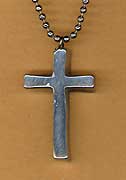|
Resources – Lent
Lenten images are not easy probably
because Lent began as a period of intense preparation
for baptism, confirmation and first communion long
before it became a penitential season in preparation for
Easter. Most of the symbols that have become connected
with it are those associated with the passion -- spear
and sponge, pillar and whips, etc.
A medieval practice revived by Percy Dearmer in his
Parson's Handbook, was to dress down the church during
Lent. Called "Lenten Array" it covered brightly
polychromed images with unbleached linen sometimes
ornamented with black and red stenciled symbols of the
object they covered. The linen blended in with the
whitewashed walls of medieval churches. This simplicity
commends itself if Lent is seen as a period of quiet
contemplation leading up to the Passion and Easter.
A few years back Trinity Church, Manhattan, asked us to
design a new Lenten Array which avoided the S&M imagery
of passion tide which characterized their Canon Edward
West designed set. Traveling by rail to Boston we were
struck by the bare trees and interpreted them as a
seasonal image. We designed a set of rough textured
off-white silk with off-center stripes of bright
red/dark red/black against which we machine embroidered
a bare tree in copper thread. What we did not know was
that during Lent Trinity decorated the sanctuary with
one large vase filled with bare branches and set it to
one side of the altar. A bit of serendipity if ever
there was one. (Note: We're so used to symmetrical,
matching flower arrangements, that one off-center
arrangement packs a lot of punch.)
This theme of the bare tree or branches holding the
promise of springtime new birth works well in northern
parts of the country but would probably be less
effective in warmer regions and totally out of synch in
Australia. However, I would suggest that the idea of
dressing down the church, plainness and not using art
and symbols during Lent may be the most powerful symbol
of all. It fits with omitting the Alleluia or going
without flowers or other ways in which we seek to
emphasize the contemplative, preparatory nature of this
liturgical season.
Paul
Woodrum of Challwood Studios,
Diocese of Long Island
Wonderful and relevant images might arise
from the the scriptures. For instance, in the first
reading, we have the rainbow, and the flood. What will
the flood fear be today? For me, it is a nuclear war. I
need to hear God's promises very clearly in face of that
fear. That week we have also the image of "like a dove"
and the waters of baptism. Any images there?
Nancy
Chinn
A Methodist minister I knew brought in an
old stump which he placed at the entry to the nave. Not
sure how he rigged it, but it began to sprout and grow
greenery as Easter drew nigh. Somehow the scattering of
seeds – the death of the old life yielding the raw
material for the new life – is interesting imagery.
Martha Berger,
Diocese of Milwaukee
As a part of Lenten preparations, all
decorative elementsmay be removed from the church. In
line with that, some churches even remove the cross
(where that is physically possible). The rationale is
that people actually develop a hunger for the cross, it
becomes more evident in its absence, and people feel it
more when it is returned on Easter.
To that end, I did once make a shroud for a cross that
was quite solid. It received a variety of responses. One
child asked if there was a body in there.
Louisa Monfort
Our children have made crosses out of
apple tree prunings with purple string. Stick the cross
in a cup of soil and top the soil with quick sprouting
grass seeds. If planted on Palm Sunday, the seed have
sprouted by Easter...now the green blade riseth. If the
apple branches are fresh they eventually sprout
themselves.
Elizabeth Foster,
Diocese of Southwestern Virginia
This year we wanted to do
something with our 3rd, 4th, and 5th grade class
that was special and relevant to Lent. We made
crosses out of pewter, allowing each student to
pour their own out of molten metal. Each student
made two crosses, one
to keep and one to give away as a means of
spreading their faith. The crosses were blessed
as part a regular mass. The students were very
enthused and attentive during this project.
Process: Masters were made out of clay. Plaster
was poured over the clay crosses. When dry, the
clay was removed from the plaster. The plaster
molds were baked to dry them out. Pewter was
poured into the molds. When removed from the
plaster, we spent a couple Sundays filing and
buffing. Total production time: 4 weeks.
Extra supervision was needed the day we poured
the metal. Safety goggles, aprons and gloves
were also required. |
 |
|
|
Discussions
Lent
Pentecost – Red
Pentecost – Green |
![]()